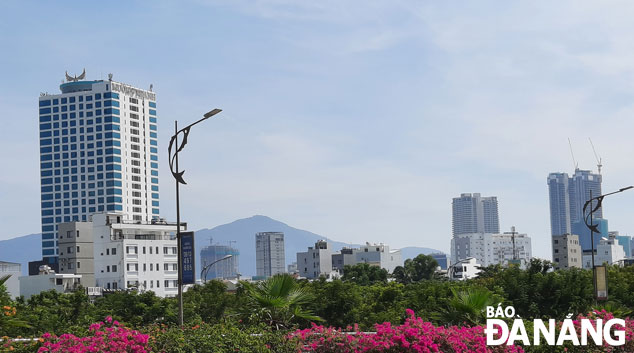Proposals made for creating new modern urban structure for Da Nang
The development of high-rise buildings in appropriate manner should be added to the strategic master plan for major developments in Da Nang to 2030, with a vision to 2045, in a bid to bring up a new aesthetically -appealing and modern facelift to the city in the future.
 |
| Clusters of high-rise buildings as noticeable landmarks should be constructed along major streets on the east-west axis linking the heart of Da Nang to beaches. Picture taken at a corner of the burgeoning Son Tra District. |
The aforementioned constructive recommendation made by domestic experts on planning and architecture at the Thursday meeting on assessing reasonable adjustments to city’s strategic master plan.
Adjustments have been made to Da Nang's strategic master plan following the Politburo-issued Resolution No 43-NQ/TW regarding the Da Nang’s development to 2030 with a vision to 2045 dated 24 January, 2016, with a target of developing Da Nang into a modern-smart, ecological and global city, and turning the city into a centre for entrepreneurship and innovation in Asia.
Given the current land shrinking due to urbanisation in Da Nang, the construction of high-rise buildings in selected parts of the city is highly feasible. In particular, urban design and applications of appropriate architectural models should be taken into account.
Architect Ngo Viet Nam Son, the Chairman of the Ho Chi Minh City-based Ngo Viet Design Consultants Company suggested that high-rise buildings should not be built near such areas as Da Nang Airport, the Dien Hai Citadel and the Marble Mountains Tourist Area, and on the Son Tra Peninsula.
Instead, the relocation of the existing An Don Industrial Park in Son Tra District, for instance, should be conducted as soon as possible in order to make room for the development of tall buildings here.
Also, clusters of high-rise buildings as noticeable landmarks should be constructed along major streets on the east-west axis linking the heart of Da Nang to beaches in tandem with the development of metro and Bus Rapid Transit (BRT) system to ease traffic congestions.
In his point of views on the application of technical solutions, Le Vinh An, the Dean of the Faculty of Architecture and Fine Arts of the city-based Duy Tan University, underlined a need for Da Nang to seek appropriate construction measures to ensure the harmonious ecological landscape and minimise the possible sea breeze interruption effect of tall buildings which may increase proportionately with their heights.
In his perspectives, Prof. Dr. Nguyen Quoc Thong, the Vice Chairman of the Viet Nam Architects’ Association highlighted importance of applying the ‘compacted / high-density urban’ model in Da Nang. This is an urban planning and urban design concept, which promotes relatively high residential density with mixed land uses. It is based on an efficient public transport system and has an urban layout which – according to its advocates – encourages walking and cycling, low energy consumption and reduced pollution.
Also, it is a good idea to construct high-rises based on a transit-oriented development (TOD) model, which is a type of urban development maximising the amount of residential, business and leisure space within walking distance of public transport. It promotes a symbiotic relationship between dense, compact urban form, and public transport use.
The sites for the application of these construction models many include important traffic hubs and such coastal parts of Da Nang as western areas of Hoang Sa, Vo Nguyen Giap and Truong Sa routes.
It is worth noting that the adjustments to the city’s strategic master plan must be made in parallel with ensuring the harmonious urban landscape and unique heritage values.
In reality, Da Nang now shows off important geographical - economic - political factors for the ambitious development of a marine urban structure imbued with its own special characteristics.
By TRIEU TUNG – Translated by A.T